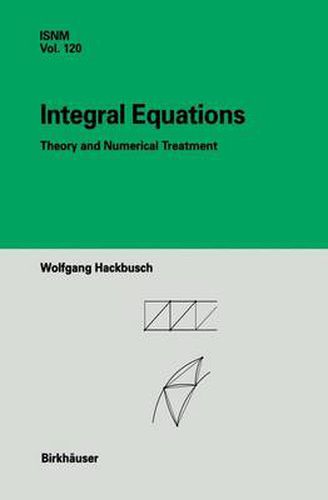Readings Newsletter
Become a Readings Member to make your shopping experience even easier.
Sign in or sign up for free!
You’re not far away from qualifying for FREE standard shipping within Australia
You’ve qualified for FREE standard shipping within Australia
The cart is loading…






This title is printed to order. This book may have been self-published. If so, we cannot guarantee the quality of the content. In the main most books will have gone through the editing process however some may not. We therefore suggest that you be aware of this before ordering this book. If in doubt check either the author or publisher’s details as we are unable to accept any returns unless they are faulty. Please contact us if you have any questions.
The theory of integral equations has been an active research field for many years and is based on analysis, function theory, and functional analysis. On the other hand, integral equations are of practical interest because of the boundary integral equation method , which transforms partial differential equations on a domain into integral equations over its boundary. This book grew out of a series of lectures given by the author at the Ruhr-Universitat Bochum and the Christian-Albrecht-Universitat zu Kiel to students of mathematics. The contents of the first six chapters correspond to an intensive lecture course of four hours per week for a semester. Readers of the book require background from analysis and the foundations of numeri cal mathematics. Knowledge of functional analysis is helpful, but to begin with some basic facts about Banach and Hilbert spaces are sufficient. The theoretical part of this book is reduced to a minimum; in Chapters 2, 4, and 5 more importance is attached to the numerical treatment of the integral equations than to their theory. Important parts of functional analysis (e. g. , the Riesz-Schauder theory) are presented without proof. We expect the reader either to be already familiar with functional analysis or to become motivated by the practical examples given here to read a book about this topic. We recall that also from a historical point of view, functional analysis was initially stimulated by the investigation of integral equations.
$9.00 standard shipping within Australia
FREE standard shipping within Australia for orders over $100.00
Express & International shipping calculated at checkout
This title is printed to order. This book may have been self-published. If so, we cannot guarantee the quality of the content. In the main most books will have gone through the editing process however some may not. We therefore suggest that you be aware of this before ordering this book. If in doubt check either the author or publisher’s details as we are unable to accept any returns unless they are faulty. Please contact us if you have any questions.
The theory of integral equations has been an active research field for many years and is based on analysis, function theory, and functional analysis. On the other hand, integral equations are of practical interest because of the boundary integral equation method , which transforms partial differential equations on a domain into integral equations over its boundary. This book grew out of a series of lectures given by the author at the Ruhr-Universitat Bochum and the Christian-Albrecht-Universitat zu Kiel to students of mathematics. The contents of the first six chapters correspond to an intensive lecture course of four hours per week for a semester. Readers of the book require background from analysis and the foundations of numeri cal mathematics. Knowledge of functional analysis is helpful, but to begin with some basic facts about Banach and Hilbert spaces are sufficient. The theoretical part of this book is reduced to a minimum; in Chapters 2, 4, and 5 more importance is attached to the numerical treatment of the integral equations than to their theory. Important parts of functional analysis (e. g. , the Riesz-Schauder theory) are presented without proof. We expect the reader either to be already familiar with functional analysis or to become motivated by the practical examples given here to read a book about this topic. We recall that also from a historical point of view, functional analysis was initially stimulated by the investigation of integral equations.